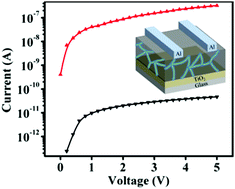Triple cation perovskite doped with the small molecule F4TCNQ for highly efficient stable photodetectors†
Abstract
Hybrid organic–inorganic perovskite photodetectors are being fabricated for high performance due to their excellent light absorption, ease of fabrication, and low cost. The large grain size and fewer defects of the film are always favorable for highly efficient stable photodetector devices. Here, the additive engineering technique is applied to the triple cation perovskite for crystal growth and defect passivation. A small organic molecule, 2,3,5,6-tetrafluoro-7,7,8,8-tetracyanoquinodimethane (F4TCNQ), is introduced in the perovskite layer. F4TCNQ promotes the reduction in metallic lead defects, decreases grain boundaries, increases grain size, and increases carrier lifetimes of the perovskite film. Moreover, F4TCNQ doped perovskite photodetectors are fabricated, which show significant device performance with a high on/off ratio, high responsivity, and low dark current. The addition of F4TCNQ also significantly improves the environmental stability of the device. This work underscores the significance of additive engineering in achieving high performance of photodetector devices by controlling grain size and defect passivation for future optoelectronic applications.



 Please wait while we load your content...
Please wait while we load your content...